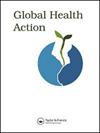蒙古五岁以下儿童遭受体罚和心理侵害的普遍程度和因素:2018 年社会指标调查分析。
IF 2.2
3区 医学
Q2 PUBLIC, ENVIRONMENTAL & OCCUPATIONAL HEALTH
引用次数: 0
摘要
背景全球暴力侵害儿童行为的发生率之高令人震惊,数百万儿童面临暴力管教和体罚。在蒙古,与家庭暴力相关的刑事犯罪急剧增加,与2019年相比,2020年第一季度激增了46.92%。本研究旨在估算5岁以下儿童遭受照顾者体罚和/或心理侵害的发生率,并确定与之相关的因素。为了研究自变量和因变量之间的关联,我们使用了多层次泊松回归,因为当流行率相对较高时,它能提供更好的估计值,也更容易解释。结果据报道,心理侵害的流行率为 32.3%,体罚的流行率为 31.6%,包括严重形式的体罚。非暴力手段很常见,77.5%的人专门使用非暴力管教手段。心理侵犯更容易发生在年龄较大的儿童(3 岁和 4 岁)和户主为佛教徒的家庭中。此外,与 2 岁儿童相比,3 岁儿童更有可能遭受体罚。这些研究结果突出表明,有必要采取有针对性的政策干预措施,包括针对不同年龄段的家长教育计划以及宗教和文化敏感性措施。全面的教育和宣传计划对于在各级教育中培养非暴力文化至关重要,这凸显了针对具体情况制定政策以保障蒙古儿童福祉的必要性。本文章由计算机程序翻译,如有差异,请以英文原文为准。
Prevalence and factors of physical punishment and psychological aggression toward children under five in Mongolia: an analysis of the 2018 Social Indicator Survey.
BACKGROUND
The global prevalence of violence against children is alarmingly high, with millions facing violent discipline and physical punishment. In Mongolia, domestic violence-related criminal offenses have sharply increased, with a 46.92% surge in the first quarter of 2020 compared to 2019.
OBJECTIVE
This study aimed to estimate the prevalence of and identify factors associated with physical punishment and/or psychological aggression experienced by children under 5 years old from their caregivers.
METHODS
We used data from the nationally representative 2018 MICS6 dataset. To examine the association between independent and dependent variables, we used multilevel Poisson regression because it provides a better estimate and is more interpretable when the prevalence is relatively high.
RESULTS
The prevalence of psychological aggression was reported at 32.3% and physical punishment at 31.6%, including severe forms. Nonviolent techniques were common, with 77.5% exclusively using nonviolent discipline. Psychological aggression was more likely to occur in older children (3 and 4 years old) and in households with Buddhist heads. Additionally, 3-year-olds are more likely to experience physical punishment compared to 2-year-olds.
CONCLUSION
These findings underscore the need for targeted policy interventions, including age-sensitive parental education programs and religious and cultural sensitivity measures. Comprehensive educational and awareness programs are essential to foster a culture of nonviolence across all educational levels, highlighting the need for context-specific policies to safeguard the well-being of children in Mongolia.
求助全文
通过发布文献求助,成功后即可免费获取论文全文。
去求助
来源期刊

Global Health Action
PUBLIC, ENVIRONMENTAL & OCCUPATIONAL HEALTH-
CiteScore
5.10
自引率
3.80%
发文量
108
审稿时长
16 weeks
期刊介绍:
Global Health Action is an international peer-reviewed Open Access journal affiliated with the Unit of Epidemiology and Global Health, Department of Public Health and Clinical Medicine at Umeå University, Sweden. The Unit hosts the Umeå International School of Public Health and the Umeå Centre for Global Health Research.
Vision: Our vision is to be a leading journal in the global health field, narrowing health information gaps and contributing to the implementation of policies and actions that lead to improved global health.
Aim: The widening gap between the winners and losers of globalisation presents major public health challenges. To meet these challenges, it is crucial to generate new knowledge and evidence in the field and in settings where the evidence is lacking, as well as to bridge the gaps between existing knowledge and implementation of relevant findings. Thus, the aim of Global Health Action is to contribute to fuelling a more concrete, hands-on approach to addressing global health challenges. Manuscripts suggesting strategies for practical interventions and research implementations where none already exist are specifically welcomed. Further, the journal encourages articles from low- and middle-income countries, while also welcoming articles originated from South-South and South-North collaborations. All articles are expected to address a global agenda and include a strong implementation or policy component.
 求助内容:
求助内容: 应助结果提醒方式:
应助结果提醒方式:


